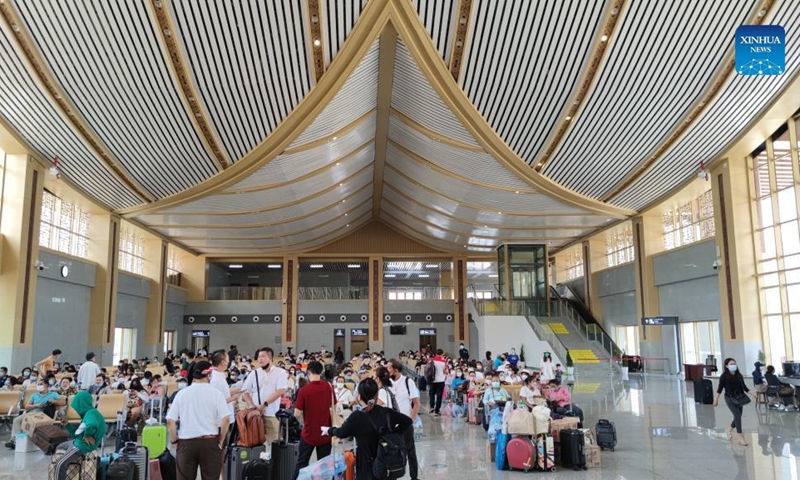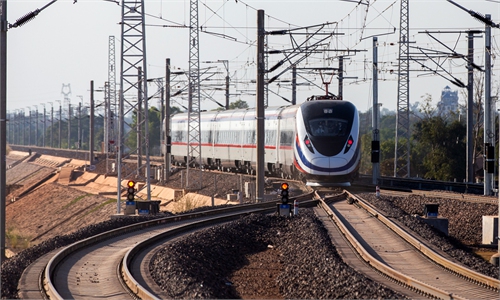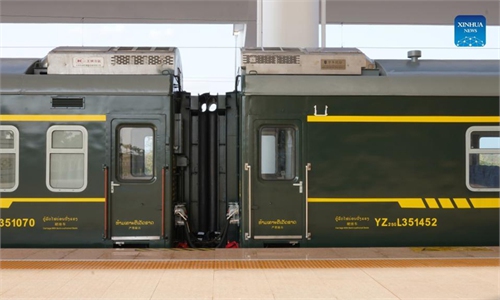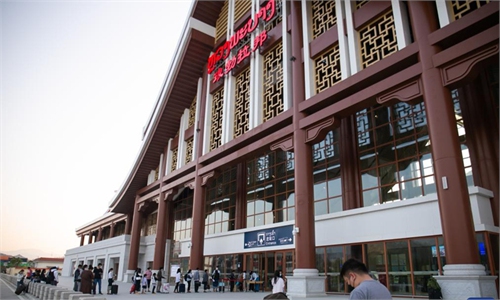
Photo taken on Feb. 13, 2022, shows the waiting hall of the Luang Prabang Station along the China-Laos Railway in Luang Prabang, Laos. The Laos-China Railway Company (LCRC) has announced it will operate slower-speed trains in addition to the two existing high-speed EMU (electric multiple unit) trains to meet the growing needs of passengers.(Photo: Xinhua)
The China-Laos Railway's first special train for enterprises cleared customs quickly at Mohan Port in Southwest China's Yunnan Province on Saturday afternoon, with 70 standard containers and a total cargo value of more than 4.1 million yuan ($649,000), China Media Group reported.
The train, running for more than 3,500 kilometers from Nanjing, East China's Jiangsu Province, to Vientiane, Laos, is carrying food supplied by state-owned China National Cereals, Oils and Foodstuffs Corp to Laos, in order to support the nation's economic development and meet the needs of local residents, showing the deep friendship between the two countries.
Experts noted that the China-Laos Railway, as a landmark project under the Belt and Road Initiative, has not only boosted travel and tourism along the line, but also brought more convenience to cross-border commerce, shortening shipping times and costs since its launch on December 3, 2021.
During China's Spring Festival travel rush from January 17 to February 25, the China-Laos Railway ran at full capacity, carrying more than 700,000 passengers and over 170,000 tons of goods, transport officials in Yunnan said.
During the 40-day travel rush, China Railway Kunming Group operated 25.5 pairs of passenger trains every day, with one bullet train running every 30 minutes. After the Spring Festival holiday, the railway saw a significant increase in passenger flow, with the railroad department running 32.5 pairs of trains per day and transporting 33,000 passengers in a single day at the peak.
Ridership on the Laos section also grew steadily, with the highest number of passengers in a single day increasing from 1,000 to more than 2,600. During the Spring Festival, 78,000 passengers used the train.
The railway has also boosted tourism alongside the route. During the travel rush, bookings in Pu'er and Xishuangbanna Dai Autonomous Prefecture in Yunnan increased 92.4 percent and 59.9 percent, respectively, from the previous year, further promoting the economic development of the province.
The railway has also promoted cross-border commerce. Since December 3, a total of 607 cargo trains have operated, sending over 170,000 tons of goods, including 151 international cargo trains.
More than 10 provinces including East China's Shandong, Zhejiang and Jiangsu provinces, have started international cargo trains to foreign cities like Vientiane via the China-Laos Railway. The types of goods have expanded from rubber and fertilizer at the beginning to electronics, photovoltaic products, automobiles, textiles, vegetables, flowers and other products.
The China-Laos Railway has 10 stations that handle cargo. With the Regional Comprehensive Economic Partnership taking effect from January 1, the freight volume of the railway has grown steadily, bringing more high-quality Chinese goods to the region, as well as injecting strong momentum for the development of industries along the route, experts noted.



